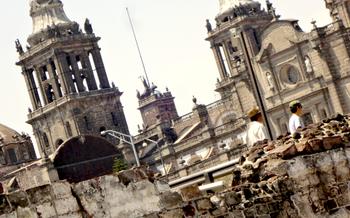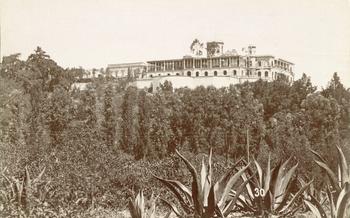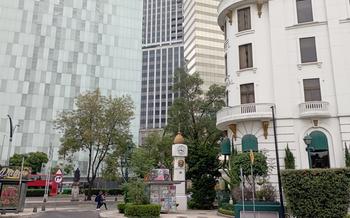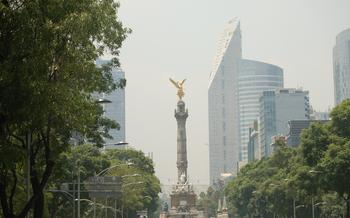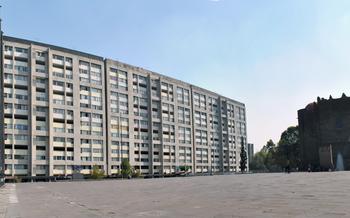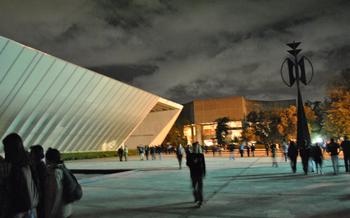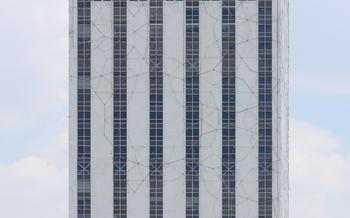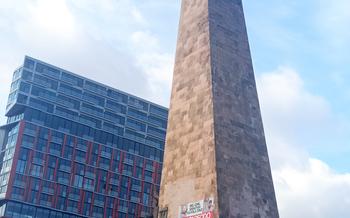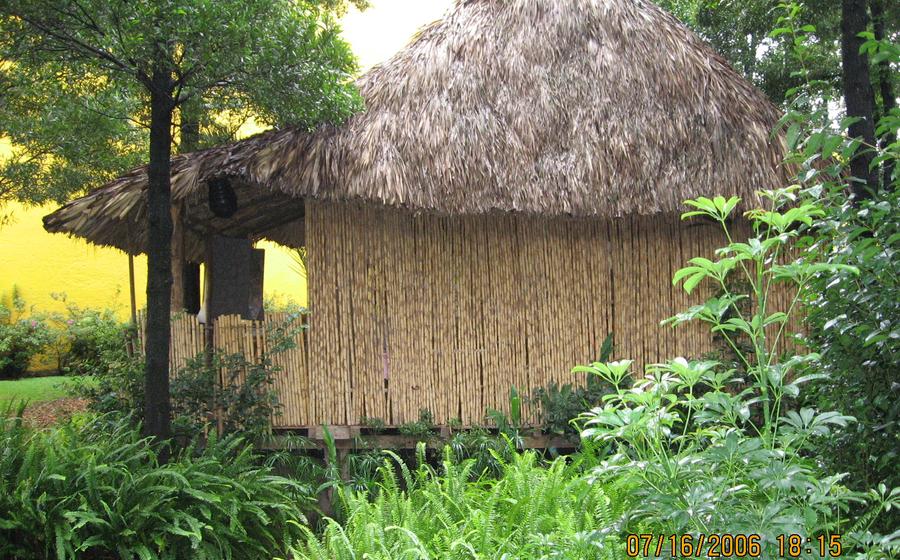
Papalote Museo del Niño
- Papalote Museo del Niño: A Place for Discovery and Learning
- Inspiring Curiosity Through Interactive Exhibits
- Nurturing Creativity in the Art Studio
- Discovering the Wonders of Science in the Science Lab
- Exploring the Wonders of the Human Body
- Encouraging Environmental Awareness in the Eco-Lab
- Promoting Teamwork and Collaboration in the Construction Zone
- Exploring the Wonders of Space in the Planetarium
- Encouraging Physical Activity in the Sports Zone
- Accommodating Children with Special Needs
- Extending the Learning Experience with Educational Programs
Papalote Museo del Niño: A Place for Discovery and Learning
In the heart of Mexico City, nestled amidst the vibrant Chapultepec Park, lies a haven for curious minds and imaginative spirits: the Papalote Museo del Niño. This interactive children's museum, inaugurated in 1993, has become a beloved destination for families seeking a unique blend of education, entertainment, and hands-on experiences. With over 300 exhibits spread across 12,000 square meters, the Papalote Museo del Niño offers an immersive journey into the realms of science, art, culture, and the wonders of the human body.
Driven by a mission to spark curiosity, creativity, and a lifelong love for learning, the museum has established itself as a leader in interactive education. Through its innovative exhibits, workshops, and educational programs, the Papalote Museo del Niño empowers children to explore their interests, challenge their assumptions, and discover the joy of discovery.
Located in the second section of Chapultepec Park, the museum is easily accessible by public transportation or car. It operates from Tuesday to Sunday, with extended hours on weekends and holidays. Admission fees vary depending on the age of the visitor, with discounts available for children, students, and seniors.
Inspiring Curiosity Through Interactive Exhibits
Interactive exhibits are a cornerstone of the Papalote Museo del Niño, designed to spark curiosity and encourage hands-on learning. These exhibits go beyond traditional displays, allowing children to engage with science, art, and culture through experimentation and play.
One popular exhibit, the "Water Lab," features interactive water tables and pumps that let children explore the properties of water and the principles of fluid dynamics. In the "Art Studio," kids can unleash their creativity by painting, drawing, and sculpting with a variety of materials. The "Science Lab" offers hands-on science experiments, such as building circuits, mixing chemicals, and dissecting specimens.
These interactive exhibits not only provide entertainment but also promote critical thinking, problem-solving, and collaboration. By actively participating in these activities, children develop a deeper understanding of scientific concepts, artistic techniques, and the world around them.
Nurturing Creativity in the Art Studio
The Papalote Museo del Niño recognizes the profound significance of art and creativity in a child's development. Within the museum's walls, an enchanting art studio awaits young minds, inviting them to delve into the realm of artistic expression. Here, children are provided with an array of materials, from vibrant paints and colorful markers to molding clay and shimmering glitter, empowering them to unleash their boundless imagination and create masterpieces that reflect their unique perspectives.
Through guided activities and open-ended exploration, the art studio fosters a nurturing environment where children can experiment, learn, and grow. Workshops conducted by experienced art educators introduce budding artists to various techniques and styles, encouraging them to explore their creativity beyond the confines of traditional mediums. Whether it's painting, drawing, sculpting, or crafting, the art studio provides a safe and supportive space for children to express themselves freely and develop their artistic abilities.
As parents, we can play a vital role in nurturing our children's creativity by providing them with opportunities to engage in artistic pursuits. Encourage your child to explore different materials and techniques, and most importantly, embrace their unique artistic style. Praise their efforts and creations, fostering a sense of confidence and self-expression. By creating a supportive environment at home, we can help our children blossom into creative and imaginative individuals.
A visit to the Papalote Museo del Niño's art studio is an unforgettable experience that sparks creativity and ignites a passion for the arts in children of all ages. As they proudly display their creations, we witness the transformative power of art and the joy it brings to their young hearts.
Discovering the Wonders of Science in the Science Lab
The Papalote Museo del Niño recognizes the significance of scientific exploration and experimentation for children's development. To foster a love for science, the museum has created an engaging science lab where kids can delve into the wonders of the natural world.
The science lab is a vibrant and interactive space equipped with various exhibits, experiments, and educational materials that bring scientific concepts to life. Children can conduct hands-on experiments that demonstrate the principles of physics, chemistry, and biology. They can explore the properties of different materials, create chemical reactions, and investigate the workings of the human body.
To make science fun and engaging, the museum employs interactive displays and multimedia presentations. Children can use touchscreens to learn about scientific phenomena, play educational games, and solve puzzles that challenge their critical thinking skills.
The science lab is not just a place for learning; it's also a place for discovery and creativity. Children are encouraged to ask questions, make hypotheses, and test their ideas through experimentation. The museum's knowledgeable staff is always on hand to provide guidance and support, helping children develop a deeper understanding of the scientific world.
One memorable anecdote from my visit to the science lab involved a young boy named Daniel. He was particularly fascinated by the exhibit on electricity. He spent a long time experimenting with different circuits and creating his own electrical contraptions. When he finally managed to light up a small bulb, his face lit up with excitement and pride. It was a moment that demonstrated the power of hands-on learning and the joy of scientific discovery.
Through its interactive exhibits and educational programs, the Papalote Museo del Niño is helping to nurture a new generation of scientists and innovators. By sparking a passion for science in children, the museum is laying the foundation for a future where scientific curiosity and creativity can thrive.
Exploring the Wonders of the Human Body
Children are naturally curious about their own bodies and how they work. The Papalote Museo del Niño provides a fun and engaging environment for kids to learn about human anatomy and physiology. The museum's human body exhibits feature interactive models, educational displays, and hands-on activities that allow children to explore the different systems of the body, from the skeletal and muscular systems to the digestive and respiratory systems.
One of the most popular exhibits is the giant walk-through heart, where kids can crawl through the chambers of the heart and learn about how blood is pumped throughout the body. Another popular exhibit is the "Body Puzzle," where children can put together a giant jigsaw puzzle of the human body to learn about the different organs and tissues.
The museum also offers a variety of educational programs and workshops on human health and the human body. These programs are designed to teach children about the importance of healthy eating, exercise, and personal hygiene.
Practical Suggestions:
- To make learning about the human body even more fun and interactive, encourage kids to dress up in doctor or nurse costumes and bring along their favorite stuffed animals to examine.
- Take your time exploring the exhibits and encourage kids to ask questions and make observations.
- Don't be afraid to get messy! The museum provides plenty of opportunities for hands-on learning, so let kids explore and experiment to their heart's content.
Anecdote:
My daughter was fascinated by the human body exhibit at the Papalote Museo del Niño. She spent hours exploring the different exhibits and learning about the different organs and systems of the body. She was particularly excited about the giant walk-through heart, where she crawled through the chambers of the heart and learned about how blood is pumped throughout the body. After our visit to the museum, my daughter was inspired to learn more about human health and the human body. She started reading books about the human body and even decided to become a doctor when she grows up.
Encouraging Environmental Awareness in the Eco-Lab
The Papalote Museo del Niño recognizes the pressing need to educate young minds about environmental issues and sustainability. To this end, the museum has dedicated an entire section of its space to the Eco-Lab, where children can immerse themselves in interactive exhibits that teach them about recycling, conservation, and renewable energy sources.
The Eco-Lab's exhibits are designed to be both educational and engaging, with hands-on activities that encourage children to think critically about their impact on the planet. They can learn about the importance of reducing waste by sorting recyclables, explore the concept of renewable energy by generating electricity through pedal power, and discover the beauty of nature by observing live insects and plants in the terrarium.
To make the learning experience even more meaningful, parents can guide their children through the Eco-Lab's exhibits by asking thought-provoking questions and facilitating discussions about environmental issues. By doing so, they can help their children develop a sense of responsibility towards the environment and inspire them to make sustainable choices in their daily lives.
Here's a personal anecdote to illustrate the impact of the Eco-Lab: During a recent visit to the museum, I observed a young girl intently studying the life cycle of a butterfly in the terrarium. As her mother explained the importance of pollination, the girl's eyes lit up with fascination. From that moment on, she became an ardent advocate for protecting butterflies and other pollinators in her neighborhood. The Eco-Lab had sparked a genuine passion for environmental conservation in her young heart.
Promoting Teamwork and Collaboration in the Construction Zone
Theoretical Notions:
Teamwork and collaboration are essential skills for children's development. Working together to achieve a common goal helps children learn how to communicate effectively, solve problems, and build relationships. The Construction Zone at the Papalote Museo del Niño provides a unique opportunity for children to develop these skills through hands-on, collaborative activities.
Informative Content:
The Construction Zone is a dedicated space within the museum where children can engage in a variety of construction-themed activities. They can work together to build structures using large foam blocks, design and construct their own cities using recycled materials, and operate heavy machinery simulators. These activities encourage children to collaborate, problem-solve, and use their imaginations to create something together.
Practical Suggestions:
To encourage teamwork and collaboration among children in the Construction Zone, parents can:
- Set a clear goal for the activity. This could be building a specific structure, designing a city, or completing a construction-related challenge.
- Encourage children to work together to achieve the goal. Remind them that they can accomplish more by working together than they can individually.
- Provide opportunities for children to share ideas and solve problems together. This could involve asking them questions about their designs, encouraging them to discuss different approaches to a challenge, or having them brainstorm solutions to problems that arise.
- Praise children for their teamwork and collaboration. When children work together effectively, be sure to praise them for their efforts. This will help them to understand the importance of teamwork and encourage them to continue working together in the future.
Anecdotes:
One afternoon, I watched a group of children working together to build a city out of recycled materials. They were so engrossed in their project that they didn't even notice me watching them. They were collaborating, problem-solving, and having a great time. At one point, one of the children had an idea for a new building. He shared his idea with the group, and they all worked together to incorporate it into their city. It was amazing to see how they were able to work together so effectively to create something that they were all proud of.
Exploring the Wonders of Space in the Planetarium
The Papalote Museo del Niño also features a state-of-the-art planetarium, where children can embark on a journey into the vast expanse of space. The planetarium offers immersive shows that take visitors through the solar system, explore the mysteries of the Milky Way, and introduce them to the wonders of stars and galaxies.
Equipped with comfortable reclining seats and a high-resolution projection system, the planetarium provides a captivating experience that stimulates children's curiosity and imagination. Interactive exhibits related to astronomy and space exploration complement the shows, allowing children to learn about the history of space travel, the work of astronauts, and the latest discoveries in astrophysics.
To make astronomy fun and accessible for children, the planetarium offers a variety of shows tailored to different age groups. Younger visitors can enjoy colorful and engaging shows that introduce basic concepts such as the planets, the sun, and the moon. Older children can explore more complex topics such as black holes, nebulae, and the search for extraterrestrial life.
One memorable anecdote from my visit to the planetarium involves a young boy who was particularly fascinated by the show about the International Space Station. After the show, he eagerly approached the museum staff with questions about how astronauts live and work in space. The staff took the time to explain the challenges and wonders of life in space, inspiring the boy to dream of becoming an astronaut himself. The planetarium at the Papalote Museo del Niño not only provides a fun and educational experience but also has the power to ignite a passion for science and space exploration in young minds.
Encouraging Physical Activity in the Sports Zone
Theoretical Notions:
Physical activity is crucial for children's overall health and development. It helps strengthen their bodies, improve their coordination and balance, and promotes cardiovascular health. Regular physical activity also contributes to children's cognitive development, social skills, and self-confidence.
Informative Content:
The Papalote Museo del Niño features a dedicated sports zone that provides children with ample opportunities to engage in physical activities. The zone is equipped with a variety of sports equipment, including balls, hoops, bean bags, and skipping ropes. Children can participate in various sports activities, such as basketball, soccer, volleyball, and relay races.
Practical Suggestions:
To make the most of the sports zone, encourage your children to try different activities and explore their interests. Let them choose the sports they want to play and provide them with guidance and support. You can also participate in the activities with your children, creating a fun and bonding experience.
Anecdotes:
One afternoon, I observed a group of children playing basketball in the sports zone. They were laughing, cheering each other on, and having a great time. It was evident that they were not only enjoying the physical activity but also developing their teamwork and social skills.
Another time, I saw a young girl hesitantly trying to climb the rock-climbing wall. With encouragement from her parents, she slowly but steadily made her way up the wall. The sense of accomplishment and pride on her face when she reached the top was priceless.
Accommodating Children with Special Needs
The Papalote Museo del Niño is committed to providing an inclusive and welcoming environment for all children, regardless of their abilities or challenges. The museum offers several accessibility features to ensure that children with special needs can fully enjoy their visit.
Wheelchair ramps and elevators provide easy access to all areas of the museum, including the exhibits, the art studio, the science lab, and the planetarium. Sensory-friendly areas are available for children who may need a break from the hustle and bustle of the museum. These areas offer calming activities and a quiet space to relax and recharge.
The museum staff is trained to be welcoming and supportive of children with special needs and their families. They can provide assistance with navigation, offer adapted activities, and ensure that everyone has a positive and rewarding experience.
Here's an anecdote that highlights the museum's commitment to inclusivity:
A young boy named Carlos, who has autism, was visiting the museum with his family. He was initially overwhelmed by the sights and sounds of the museum, but the staff was incredibly patient and understanding. They helped him find a quiet space to calm down and then slowly introduced him to the exhibits. Carlos gradually became more comfortable and engaged, and he ended up having a wonderful time exploring the museum with his family.
Extending the Learning Experience with Educational Programs
The Papalote Museo del Niño offers a variety of educational programs, workshops, and field trips to supplement the museum visit and enhance the learning experience for children. These programs are designed to delve deeper into specific subjects, foster creativity, and encourage hands-on exploration.
The museum's educational programs cover a wide range of topics, including science, art, history, and culture. Workshops are typically offered during the weekends and school holidays, and they provide children with the opportunity to engage in hands-on activities and create their own projects. Field trips are organized for schools and groups, allowing students to explore the museum's exhibits and participate in educational activities under the guidance of experienced educators.
To select the right educational program for your child, consider their interests and needs. The museum's website provides detailed information on each program, including age recommendations, duration, and fees. You can also contact the museum's education department for personalized recommendations and assistance in choosing the most suitable program for your child.
Participating in the museum's educational programs can greatly enhance children's learning experience. These programs provide opportunities for children to explore their interests in depth, develop new skills, and make meaningful connections with the world around them. They also foster a love for learning and encourage children to become lifelong learners.
